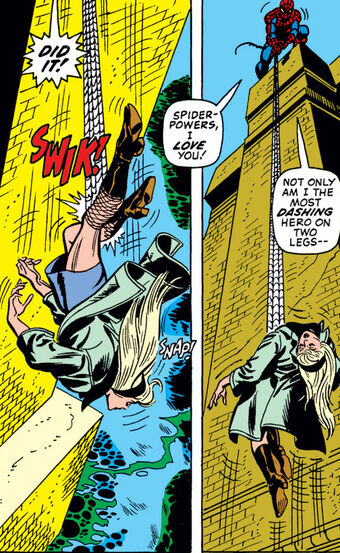My Recent Reads
The Amazing Spider-Man #91
Originally Published December 1, 1970
Writer: Stan Lee
Artist: Gil Kane
- Spidey/Peter Parker struggles to come to terms with George Stacy's death while also dealing with the fact that everyone, most importantly his own girlfriend, blames him for the accident.
- Nemesis: Sam Bullit, a crooked lawyer running for district attorney, looking to capitalize on Spidey's current unpopularity in his own "tough on crime" campaign
 |
| Robbie Robertson via Wikipedia |
- Featured: Robbie Robertson, the editor of The Daily Bugle and one of the first recurring Black characters in a major comic book series
The Amazing Spider-Man #92
January 1, 1971
Lee/Kane
- Featured: Iceman, who picks a fight when he misinterprets (sort of) Spidey's kidnapping of Gwen. The kidnapping is part of an effort to preserve his secret identity. It's a little icky. As much as we want our man to always be right, Iceman was probably correct to interfere.
- Sam Bullit's evils are exposed.
 |
| via Wikipedia |
- Artist Gil Kane was born Eli Katz in Riga, Latvia on April 6, 1926. His family emigrated to Brooklyn, New York in 1929. He started working in the comics industry at age 16. Over his career, he worked with every major publisher, including Archie, DC and, of course, Marvel. He was co-creator of the Silver Age Green Lantern, Atom and Iron Fist. He was also an early pioneer in the graphic novel format. Kane passed away in 2000 from complications of lymphoma.
- Catch your breath. Here we go...
The Amazing Spider-Man #121
June 1, 1973
Writer: Gerry Conway
Artist: Kane
- Probably the single most important issue in the history of the American comic book industry.
- Gwen Stacy dies.
- It's difficult to overstate the significance of Gwen Stacy's death. Since 1954, the entire medium had been living under the Comics Code Authority (CCA) which imposed even more stifling restrictions than the comparable code employed for motion pictures. The lack of dimension in comic books of the 1950s and '60s can largely blamed on the CCA.
- As a result, the readership had come to have certain expectations about superheroes and their stories. Marvel had already begun to push the limits with The Amazing Spider-Man. In issues #96-98, Harry Osborn took LSD and his friends struggled to help him with his drug problem. They had back up on that one, the US Department of Health, Education and Welfare having asked them to run an anti-drug story.
- George Stacy's death in issue #90 was ground-breaking in itself but Gwen's death went a step further as Spidey's own role in the accident is less clear. Yes, the Green Goblin threw her off the top of the George Washington Bridge but her neck snapped when Spidey tried to save her with his webbing. In effect, Spider-Man accidentally caused her death. Interestingly, the Green Goblin himself lets Spidey off the hook, asserting that the fall itself had likely already killed her. Nonetheless, the question remains.
 |
| via Marvel Database |
- Gwen Stacy's death is broadly considered to be the moment when the American comic book medium lost its innocence. Spider-Man's good guy identity ultimately survived but the door was kicked open for morally ambiguous heroes and edgier storylines.
- This issue is also considered by many to mark the ending of the Silver Age of comic books.
- As if that weren't enough, Harry has his second bad acid trip in this issue. Norman Osborn (alias: Green Goblin - boy has that story gotten complicated!) blames Harry's friends, including Peter, and kicks them out of the house when they come around to check on him.
 |
| via Wikipedia |
- Featured: Mary Jane Watson. When I left the series after #38, we hadn't even seen her face yet.
The Amazing Spider-Man #122
July 1, 1973
Conway/Kane
- Peter/Spidey is enraged over Gwen Stacy's death.
- Peter walks out on Harry while the latter is in need, still freaking out over his bad trip.
- Mary Jane, however, turns out to be a better friend. Peter is horrible to her when she meets him at his apartment and he sends her away. In the issue's final frame, we see she's sticking around to tough it out with him.
 |
| via Spiderman animated Wikia |
- Writer Gerry Conway was born September 10, 1952 in New York City. A comic book wunderkind, he published his first professional work at age 16 and succeeded Stan Lee as lead writer for The Amazing Spider-Man, Marvel's flagship, at 19. He also co-created The Punisher for Marvel and Firestorm for DC, where he was the writer for Justice League of America for eight years.
- Before moving on, I'd like to quickly reaffirm that The Amazing Spider-Man is definitely the best series Marvel had going in the Silver Age and the Peter Parker side of the story is largely the reason why.
Howard the Duck #1
January 1, 1976
Steve Gerber/Frank Brunner
- And now for something completely different...
 |
| via Wikipedia |
- Howard the Duck was the co-creation of Gerber and artist Val Mayerik. The character first appeared in Adventure into Fear #19 in December 1973. In 1976, he got his own series. He is a talking and cigar-smoking duck from outer space. He's angry. He's depressed, opening with suicidal thoughts in this initial offering. Howard's stories are dark satire, spoofing their own genre in the process. Unsubtle social commentary drips from the (digital) pages.
- Unlike most of the New York-based Marvel Universe, Howard dwells in the decidedly less glamorous Cleveland, Ohio, an easily maligned city in the mid-'70s. At one point, Howard accidentally sets fire to the deeply polluted Cuyahoga River. That happened in the real world, too. Several times. Today, there's a beer from the region called Burning River Pale Ale.
- Well worth noting, though, Cleveland is a very important city to comic book history. For starters, it was the early stomping ground of Jerry Siegel and Joe Shuster, co-creators of Superman. It has been home to a thriving indy industry for decades.
- The city also boasts a top-notch art museum and one of the finest symphony orchestras in the world. All of that steel money was good for something.
- It's also where my mom's from so back off!
 |
| via Marvel Database |
- In #1, Howard meets his scantily clad sidekick, though not yet girlfriend, Beverly Switzler.
- Beverly has been kidnapped by Pro-Rata, a deranged super-villain accountant in a Dr. Strange-esque dreamscape. Nope, not kidding. Welcome to Howard the Duck.
Howard the Duck #2
March 1, 1976
Gerber/Brunner
- Villain: Turnip-Man, created when Arthur Winslow, Beverly's friend-but-not-boyfriend, is possessed by an extra-terrestrial root vegetable.
- James Bond reference! The Man with the Golden Gun was, at the time, the most recent film release:
Howard the Duck #3
May 1, 1976
Gerber/John Buscema
- Villain: Count Macho
- Horrified by a street brawl turned deadly, and the glorification of violence in general, Howard learns the martial art of Quack-Fu.
What a killer! All that power and being unable to save Stacy and the Green Goblin, did Spidey ever make him pay for throwing her off the G W Bridge?
ReplyDeleteWhy yes he did! Under a time crunch, I posted without getting into that because it's rather complicated - deliciously so.
DeleteSpidey didn't kill GG. However, he sort of allowed him to die - or at least Spidey still believes he's dead by issue's end.
I've always wanted to read the old Howard comics. The character's importance in comic book evolution is mostly overlooked.
ReplyDeleteI don't feel like I need to comment on the Spidey stuff since I've made clear my feelings about Spider-Man often enough.
It's a major shift in tone - refreshing! I'm not sure if I'll still feel that way after 33 issues but I'm enjoying it so far.
Delete